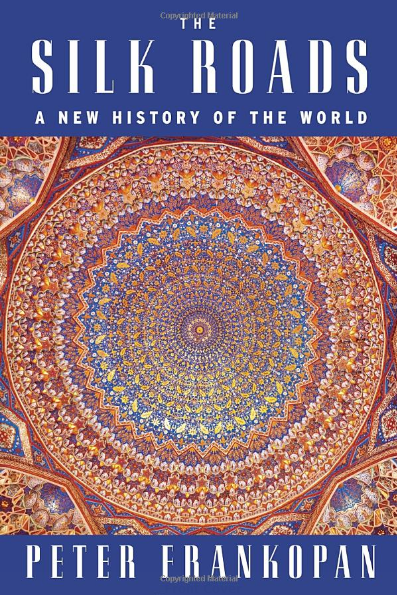The Silk Roads: Crossroads of Civilizations
By staff reporter ZHOU LIN

The Silk Roads: A New History of the World
Author: Peter Frankopan
Price: US $38.99
Hardcover
Published by Alfred A. Knopf in the U.S.
THE Silk Road is not the focus of The Silk Roads: A New History of the World. The book is rather an account of how the origins of this epic route shaped world history as a whole.
Early world history took the form of a patchwork of individual countries’ economic and social evolution. It was when historians looked beyond nation states to entire civilizations and their diplomatic relations and conflicts that historical accounts converged to form world history. What were the relationships among these various civilizations? And how was balance maintained? The answers do not lie in treating one civilization as supreme, nor from the perspective of the clashes of these titans.
Dr. Peter Frankopan is a historian at Oxford University, where he is a Senior Research Fellow at Worcester College and Director of the Oxford Centre for Byzantine Research. He wisely chooses the Silk Road, in its capacity as a path to different civilizations, rather than a particular country, as a vantage point for the evolving panorama of various civilizations.
Frankopan recalls in the book’s preface his most cherished childhood treasure – the huge world map that hung on his bedroom wall. He studied the map every night until he knew the names of all countries and regions. By the time he was a teenager Frankopan had lost interest in geography classes at school, because their focus was on Western Europe and the United States, as if nowhere else existed.
During his middle school years Frankopan’s parents gave him a book by the anthropologist Eric Wolf. It showed him that by rearranging the world map with the Caspian Sea at the center, the crux of the world is neither Western Europe nor the United States.
“Greek mythology holds that Zeus once released two eagles at each end of the Earth and ordered them to fly towards each other. A sacred stone called the omphalos – the navel of the world – was placed where the eagles met.” This tale inspired Frankopan, as he told The Times. “I remember gazing at my map...wondering where the eagles would have met. I placed one finger on the western edge of Europe, the other on the eastern edge of China and brought them together. The meeting point was always somewhere between the Black Sea and the Himalayas.”
The locale that Frankopan found so compelling was the Silk Road, the concept which German geographer Ferdinand von Richthofen coined in 1877. He mapped the routes spanning the Eurasian Continent based on Chinese and European historians’ records of trade between China and the Western world. Frankopan hence refers to the Silk Roads rather than the more conventional singular name for this network of trade routes. The book’s 25 chapters associate the Silk Roads not just with the silk, furs, and slaves that were traded along them, but also with the beliefs and hegemonies they introduced. Frankopan thus refers to intangible entities as well as commodities that traveled along the ancient route.
The Silk Roads’ biggest influence on human civilization was without doubt the cultures, religions, and technologies that traveled along them. They were a meeting place for the East – ancient Babylon, Egypt, India, and China, and the West – ancient Greece and Rome, the cultural foundations of the Western world. After the great geographical discoveries of the 16th century, the civilizations of Latin and North America also became prominent in people-to-people exchanges and logistics. Central Asia, West Asia and East Europe, as center of the Eurasian Continent, constituted the main body of the Silk Roads, wherein different civilizations met and prospered.
The Silk Roads were hence where people met to exchange commodities and ideas, but also where different civilizations competed. The book is like a scroll painting depicting a 2,000-year epoch of world history. As Frankopan observes, until the West rose to dominance in the 16th century, the eastern Silk Road was the world’s epicenter. It was here that the earliest cities and empires appeared, and where major religions were disseminated across entire nations. Commerce on the ancient Silk Roads laid the foundations some 2,000 years ago for globalization today. But it was also where scholars communicated and contributed their wisdom to the creation of splendid arts and cultures.
The Silk Roads acted as a platform to celebrate the magnificence of different human civilizations, and also as a means for individual cultures to acquire resources. Throughout the long course of its history, in the wake of battles for resources and cargoes, the Silk Roads witnessed the sharing of interests and development of civilizations. The history of the Silk Roads is indeed a condensed world history. Frankopan’s monograph thus highlights the inestimable value of China’s Belt and Road Initiative.
The New Yorker said in its review of Frankopan’s book, “This provocative history challenges the view of the West as heir to a pure Greco-Roman culture. Frankopan marshals diverse examples to demonstrate the interconnectedness of cultures, showing in vivid detail the economic and social impact of the silk and the slave trades, and the Buddhist influence on Christianity.” The Guardian called it “a proper historical epic of dazzling range and achievement.”
Services
Economy
- Chinese Manufacturing Sector Rides Fourth Industrial Revolution Wave
- China, Sri Lanka Strengthen Cooperation on Maritime Silk Road Interview with Sri Lankan Ambassador to China Karunasena Kodituwakku
- The Challenge of Understanding China and Its Future
- Promoting Further Development through Communication and Cooperation
- The Belt and Road Augurs a Community of Shared Destiny
